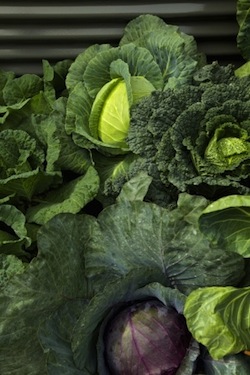As we head into winter, the usual ailments start to raise their heads and we dread the onset of the coughs, runny noses and aches and pains attached to colds and flu. While we can’t avoid them completely, there’s always the hope that a healthy diet and a healthy lifestyle will make them shorter and more bearable.
Most of us can’t afford the expensive supplements and time-consuming exercise routines recommended by the glossy magazines to keep us healthy, but there’s plenty we can do almost for free.
Top of the list, as ever, is to take a look at the garden. In fact, just going out and looking at it is the first way you can increase your vitamin levels: standing in the sunshine will help you produce vitamin D, needed for healthy bones. So head off into the back yard, regardless how big or small it is, and see what you’ve got and what you might be able to add for the coming months.
Now that the rain has returned and the soil has softened a bit, there are plenty of options for winter vege growing. It’s always startling how well lettuces survive all year round, at least in the North Island (sorry, those of you in Dunedin!) and the frilly-leafed varieties like the oak leaf type seem particularly hardy, as well as attractive in salads. Beetroot, most of the brassicas (cauliflowers, broccoli and cabbage, as well as various Chinese greens) and carrots enjoy cooler weather and it doesn’t need a lot of space to grow a few of each. Even if all you have is a planter box, you can manage a mini-vege garden which will keep the children intrigued. The dreaded green leafies, much detested by many children (and their parents) are also good winter growers and in fact they can be dealt with so as to be either hidden, or positively attractive – kale chips are actually regarded as fun by many children, and spinach can be hidden very effectively in rissoles and frittatas.
If your garden is big enough to harbour more than one bed, you can also manage things like rhubarb, which again grows well all year round in more northern areas, and citrus trees. Citruses are great for neighbourhood interaction as well – if you have a lemon (or a mandarin, or an orange) that’s growing well, you will almost certainly have more than you can possibly use. Your next-door neighbours might not be so lucky, so offer your spare produce around the street and make someone’s day: it might make yours as well, since social interactions are great for fending off depression and loneliness (both of which seem to make you more prone to minor ailments), and the walk gives you some aerobic exercise.
We are beset by “good” advice when it comes to food, much of which is subject to revision. Just as an example, we have been told in the past never to touch eggs because they cause heart disease – that has now been modified in the light of better research, and eggs can be enjoyed in moderation for the excellent nutrition-packed delights they really are. Similarly, we have, over the past couple of decades, demonised fat of all kinds, carbohydrates of most kinds, and most recently sugar is the cause of all our woes. The latter is the most likely to be a truly serious issue, since there is mounting evidence that sugary soft drinks really are a health menace, and refined sugar is certainly not a necessary part of the diet. Again, this is where the garden can help, by providing fresh, balanced nutrition without the high levels of sugar our modern processed diets have introduced. When you can pick a mandarin off your own tree, or dig a carrot out of your own patch for a tasty snack, popcorn and fizzy drinks may seem just a bit less attractive.
And just to get you going on dealing with the green leafy vegetable problem, try the following recipes for kale chips and sneaky rissoles:
Kale Chips
You need a kale plant or two, which isn’t too difficult: they grow very easily and persist in doing so even in cold weather. Pick plenty of fresh kale leaves, give them a good wash and pat them dry. Trim out the central stalks and tear the leaves into decent bite-sized pieces. Place on an oven tray and drizzle with about 1 Tbsp of cooking oil. Bake at about 170-180°C for about 10 minutes, turning once during the cooking process – they should be crisp but not blackened! Season with a small sprinkle of salt and serve instantly. Crunchy and very yummy…
Sneaky rissoles
These are great – they can be used for hamburgers, as rissoles, or turned into meatballs with a tomato-based sauce, and are a cunning way of getting a few vegetables into reluctant children at the same time as spinning out the meat a lot further than it might be expected to go!
- 500g mince, low fat if possible
- 1 egg
- 2-3 Tbsp tomato sauce
- 1 tsp salt
- Ground black pepper to taste
- A good bunch of spinach leaves, washed and finely chopped
- 2 medium carrots, grated
- About ¾ cup fresh ordinary breadcrumbs, or quick-cooking rolled oats, or gluten-free breadcrumbs, depending on your dietary preferences – add enough to get the mixture firm enough to handle and shape into patties
Mix all ingredients in a large bowl, using your hands.
Divide into 12 to 14 portions and roll them into balls, then flatten between the palms of your hands.
Fry in a shallow layer of oil in a large heavy-based frying pan over medium heat until nicely browned on both sides and cooked through.
Can be served as hamburger patties with salad, or used more traditionally as rissoles with potatoes, beans etc and fried onion rings as an accompaniment.






